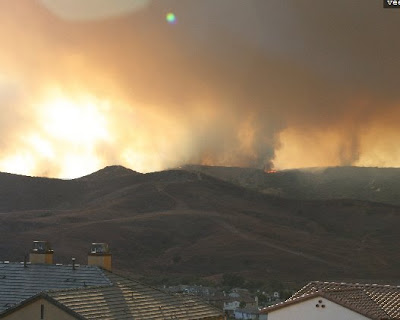The "November" fire that started on the military base 40 miles north of San Diego at 3:30 p.m. on Wednesday grew to about 1,000 acres by late evening and is 70% contained, Cal Fire Capt. Nick Schuler said. The fire is adjacent to a golf course but no structures are threatened. It is burning in an area used to train Marines in disposing of explosives.
Firefighters were using a total of 10 aircraft yesterday, including the two CL-415 "Super Scoopers" that San Diego County has on contract from a Canadian company. The CL-415's were scooping water out of the Pacific ocean which was just a few miles from the fire.
 The humidity is expected to remain high throughout the day today, which will help firefighters pick up that additional 30% containment.
The humidity is expected to remain high throughout the day today, which will help firefighters pick up that additional 30% containment.Camp Pendleton, one of the largest bases in the country, takes up 125,000 acres in northern San Diego County. It is home to the 1st Marine Expeditionary Force. The Marine Corps established the base in 1942.
Photos, courtesy of nbcsandiego.com
Update at 12:50 PT, Thursday, Oct. 9
The fire is now 100% contained at "1,400 to 1,900 acres", according to Marine Major Kristen Lasica.
Researchers: Ozone pollution in wildfires exceeds health standards
According to a press release from the National Science Foundation:
Wildfires can boost ozone pollution to levels that violate U.S. health standards, a new study concludes.
The research, by scientists at the National Center for Atmospheric Research (NCAR) in Boulder, Colo., focused on California wildfires in 2007, finding that they repeatedly caused ground-level ozone to spike to unhealthy levels across a broad area, including much of rural California as well as neighboring Nevada.
Results of the study are published today in the journal Geophysical Research Letters, published by the American Geophysical Union. The research was funded by the National Science Foundation (NSF), which sponsors NCAR, and by NASA.
"It's important to understand the health impacts of wildfires," says NCAR scientist Gabriele Pfister, the paper's lead author. "We found that ozone can hit unhealthy levels even in places where you are not seeing any smoke."
Although scientists have long known that wildfires can affect air quality by emitting particles and gases into the air, there has been little research to quantify the impacts.
Fires worsen ozone levels by releasing nitrogen oxides and hydrocarbons, which can form ozone near the fire or far downwind as a result of chemical reactions in sunlight.
The researchers, using a combination of computer models and ground-level measurements, focused on intense California wildfires that broke out in September and October of 2007. They found that ozone was three times more likely to exceed safe levels when fire plumes blew into a region than when no plumes were present.
"Increasingly in the atmospheric sciences, the blending of model results and observations yield new insights into complex natural processes and societal impacts," said Cliff Jacobs, program director in NSF's Division of Atmospheric Sciences. "This study is an excellent example of this research paradigm."
At the time of the wildfires, the public health standard for ozone set by the Environmental Protection Agency (EPA) was 0.08 parts per million over an eight-hour period. The EPA has since tightened the standard to 0.075 parts per million. Under the stricter standard, the number of violations would have nearly doubled.
While ozone in the stratosphere benefits life on Earth by blocking ultraviolet radiation from the Sun, ozone in the lower atmosphere can trigger a number of health problems. These range from coughing and throat irritation to more serious problems, such as aggravation of asthma, bronchitis, and emphysema. Ground-level ozone pollution also damages crops and other plants.
"Wildfires are expected to worsen in the future, especially as our climate grows warmer," Pfister says. "But we are only now beginning to understand their potential impacts on people and ecosystems, not only nearby but also potentially far downwind."
New generation fire shelters
According to the National Fire and Aviation Executive Board (NFAEB), Federal Agencies should be transitioned to the New Generation Fire Shelter by January 1, 2009. All agencies, cooperators and contracted resources are to be transitioned by January 1, 2010. More information is HERE.





1 comment:
For those near the wildfires, here’s a tip. When California was hit by wildfires this summer, as Contra Costa Times journalist Janis Mara reported, many homeowners got an AspenAir Inside home air cleaning unit to quickly removed the smoke that came inside. It removed the tiny, dangerous RSPs that go deep in the lungs to exacerbate asthma, allergies and other respiratory diseases. Those most at risk are infants, the elderly (less lung capacity), work-at-homes and those who already have breathing problems.
Post a Comment